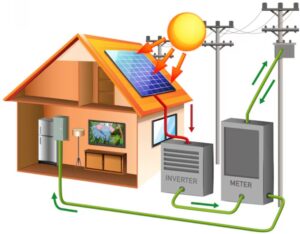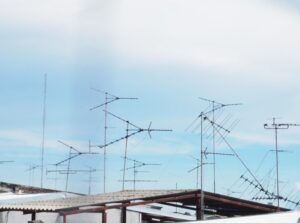Lightning Protection System In India
Climate change and rapid urbanization have ensured a dual impact on increasing the frequency and intensity of lightning protection system in India. Because of seasonal thunderstorms during the monsoon season, India easily becomes prone to greater risks associated with lightning. Above all, the role of lightning is highly disastrous to human life apart from other infrastructures, so it is a priority that, with shifting weather patterns, reliable and efficient LPS is not only desirable but highly imperative. Being the name of trusted industries, Aashapuri Engineering Pvt Ltd is at the pinnacle in innovative and efficient lightning protection solutions. In this regard, it makes comprehensive customized solutions that mitigate dangers due to lightning strikes.

What is lightning, and why is it so dangerous?
As known, lightning is a natural electrical discharge of very high power during a thunderstorm between clouds or between the clouds and the ground. It is a rapid, powerful release of electrical energy that might bring terrible impacts. That is five times hotter than the surface of the sun, reaching temperatures as high as 30,000°F (16,600°C). This high temperature might be the cause of fires breaking out, buildings getting demolished, and electronic devices malfunctioning. More importantly, lightning strike injuries are lethal. Therefore, the number one killer in a thunderstorm is the lightning strike.
The Indian monsoon comprises heavy rainstorms that are characterized by electrical storms. The lightning strikes in such a scenario pose grave threats:
Strikes of lightning are among the leading natural hazards for injury and death during storms. Most survivors of the strikes also experience crippling long-term physical and psychological consequences.
- Infrastructure: The majority of these facilities include industrial, residential communications towers, and power grids that are prone to lightning strikes. A direct strike will be able to induce structural failure, fire, and disruption of operations.
- Electronics and Machinery: Surges due to lightning strikes may burn sensitive electric equipment and render them inoperable. This includes very important medical equipment, manufacturing, and communication equipment.
Given the frequency of lightning strikes, especially during the monsoon season, the importance of a well-designed lightning protection system has become undeniable.
The Role and Importance of Lightning Protection Systems (LPS)
The LPS is a safety system that conducts the electrical charge of the lightning strike to the ground whence it can be dissipated without harm. This will ensure the protection of people and property from devastating lightning effects. Some key benefits of an effective LPS installation are as under.
- Protection of Human Life
The most important purpose of LPS is the protection of human life. A direct strike by lightning can cause fatal injuries, burns, and cardiac arrest. The provision of a safe route for the electrical discharge means that LPS diminishes the risks and prevents fatalities, while serious injuries are reduced to a minimum. - Protection of Property and Infrastructure
These effects of a lightning strike lead to enormous losses concerning buildings, machinery, electronic systems, and even a complete facility. In industries dealing with high-value assets and equipment, an efficient LPS ensures that the property is protected against the devastating force of the lightning strike. Additionally, the surge protection devices installed in the LPS protect sensitive electronic devices against the power surges generated by the strike of lightning. - Business Continuity End
This may result in prolonged downtime and huge economic loss for sectors where continuous operations are vital. A properly designed LPS tries to minimize the disruption of industrial operations as much as possible through the protection of sensitive equipment and systems against such incidences. It is, therefore, very essential in the lines of industries that rely on electronic systems to function, such as health, data centers, and manufacturing sectors. - Reduction in Insurance Costs
Buildings and other facilities with installed certified lightning protection systems may receive lower insurance premiums. Because the chances of damage from lightning are drastically reduced, insurance companies see these properties as less risk, which may equate to significant savings in cost for property and business owners. - Assisting in Renewable Energy Projects
As India gears up with more investments in Renewable Energy, especially wind and solar, protection of renewable energy infrastructure against lightning is paramount. Wind turbines are tall, with sensitive electrical systems that are most prone to strikes. A well-designed LPS can ensure the wind turbines and panels continue generating energy without discontinuation and save one from repairs and downtime, which could be considerably expensive.
Key Components of a Lightning Protection System
A well-integrated LPS comprises several components working together to afford protection to structures from the deleterious effects of lightning. These include but are not limited to, air terminals – also known as lightning rods, conductors, grounding systems, surge protectors, and bonding systems. Further, appropriate material and component selection will go a long way toward assuring effectiveness and durability for the entire system. Components of a basic LPS include:
- Air Terminals (Lightning Rods)
Air terminals are installed on the highest points of a structure, either on rooftops or chimneys, where they attract lightning strikes. Once the lightning is attracted to the air terminal, the electrical charge is coursed safely into the LPS without damage to other, more susceptible parts of the structure. Air terminals play an important role in ensuring the electrical discharge is intercepted at a specified location with reduced fire, structural, or electrical hazards. - Conductors
The conductors are metallic cables that connect air terminals to the grounding system. These cables must be sturdy enough not to break, burn, or melt from the immense electrical energy conveyed by a lightning discharge. The conductors provide a path that electric charge follows from the air terminal to the grounding system. - Grounding System
The concern of the grounding system, in simple words, is the dissipation of electrical charge into the earth from the lightning strike. The charge has to be neutralized so that no risk would further result in secondary damages to the structure or its occupants. A well-designed grounding system is essential in an effective LPS to safely dissipate electrical energy to the ground. - Surge Protection Devices (SPDs)
The SPDs are very vital as far as the protection of vulnerable electronic devices from the negative impact of power surges due to lightning strike action is concerned. In any electrical system, surge protector installation prevents voltage spikes that may damage computers, medical equipment, and industrial machinery among other devices. This absorbs and diverts excess voltage to direct them away so that the electronic systems continue functioning even during a lightning storm. - Bonding Systems
This involves connecting all the metallic parts of a building or structure such that they all have the same electric potential. This prevents “side flashes,” where lightning may strike one metal object and jump to another, thereby causing further damage. Proper bonding helps prevent secondary hazards due to a lightning strike, reducing the possibility of additional fires or electrical damage.
FRP Components in Lightning Protection Systems
FRP components possess many desirable properties of durability and strength that find a wide area of application in corrosion resistance during the construction of lightning protection systems. FRP components are often used in those structures that require not only lightning protection but also structural integrity, and these include wind turbines and high-rise buildings. Key FRP components used in the LPS include:
- FRP Receptor Tip: This is one of the most important parts designed for lightning strikes in a safe way. FRP resists corrosion and is strong, hence most suitable in extreme weather conditions.
- Black Tube: These are used to retain the cables safely and also to protect them inside the LPS. FRP Tubes protectively cover insulation to ensure that conductors and surge protection cables are routed safely.
- FRP Receptor Plate: These are installed with the receptor tips as part of the whole FRP receptor plate to provide the final collection point of the lightning strike and funnel it safely to the ground.
SS Fasteners and Aluminum Components
SS fasteners are used to fasten the different parts of a lightning protection system at crucial places. SS fasteners are highly resistant to corrosion and thus find a suitable application in outdoor and exposed applications. These fasteners contribute to keeping components such as air terminals, conductors, and grounding systems tightly in place through such extreme circumstances as arise during a lightning strike.
Aluminum Components:
- Receptor Bolt-Aluminum 6082T6: The receptor bolt is a critical part of the air terminal assembly, attaching the receptor plate to the structure. Aluminum 6082T6 is a high-strength alloy that does not corrode easily and resists the high stresses accruing in a lightning protection system.
- Cable Lug DL70-Aluminum 1070: Used for connecting cables to the grounding system or other LPS components. The high electrical conductivity and corrosion resistance of the aluminum 1070 material ensure safety in conducting electrical energy.
- H-Clamp JH – 3A: H-clamps are used to fasten conductors in a position that does not get loosed or broken due to extreme weather conditions. Aluminum 1070 is strong and resistant to corrosion; thus, it is suitable for this purpose.
- Receptor Bolt-Aluminum 6082T6: The receptor bolt is a critical part of the air terminal assembly, attaching the receptor plate to the structure. Aluminum 6082T6 is a high-strength alloy that does not corrode easily and resists the high stresses accruing in a lightning protection system.
Key Cable Components:
- GLM 70 Cable Connector (Aluminium 1070): This is a connector used to join the cables together for firmness in place. The aluminum 1070 alloy will guarantee that the connector is strong enough for the electrical load it will carry in case of a strike.
- Cable Assembly 70mm² HT and LT Aluminium Cable: The assembly will include high-tensile, and low-tensile aluminium cables that are used to convey the electrical energy from the air terminal down to the grounding system. The size is 70mm² to ensure the cable can support the large quantity of electrical energy produced during a lightning strike.
Lightning Protection for Wind Turbines
With increasing investment in renewable energy, there is an increasing need in these modern times to protect wind turbines against lightning. The height at which wind turbines are installed, coupled with the use of conductive materials in constructing the blades, makes these giant fans prone to lightning strikes. By nature, wind turbines stand openly and high, and hence electrical systems sensitive by nature make them quite vulnerable to lightning. This will serve to guarantee a good LPS installation at the wind turbines to lessen downtowns and save money from costly repairs.
Protecting the Wind Turbines: Why?
- Material Sensitivity: The usually used material on the blades of the wind turbine is composite materials, which are very sensitive to lightning strikes.
- Operational Disruption: The lightning strike may disrupt the operation of the turbine and result in lost energy production.
- Fire Hazard: A stroke of lightning may ignite a fire in a jiffy which could also cause danger for personnel and extensive damage to the turbine.
How Turbine Protection Works
Protection of wind turbines involves embedding conductive materials within the turbine blades and air terminals, conductors, and grounding systems to safely route the energy of a lightning discharge to the ground. All these systems require periodic maintenance and inspections to make sure the turbines remain protected and operational.
Aashapuri Engineering Pvt Ltd is one of the leaders in providing advanced lightning protection systems in India. Focused on quality and reliability, the company offers comprehensive solutions designed to protect buildings, industrial sites, wind turbines, and renewable energy installations against harmful lightning strikes. Their skilled team works toward creating tailor-made LPS to suit each client’s needs uniquely.
Why Choose Aashapuri Engineering Pvt Ltd?
- Experience and Expertise: The experience gathered by Aashapuri Engineering in the field of design, installation, and maintenance in lightning protection is immense, hailing from decades.
- Custom Solutions: They offer custom-made solutions for a wide array of structures to make sure of the best protection.
- Quality Assurance: Products designed by this company follow both the national and international guidelines regarding their standards, hence ensuring complete protection to the customers.
- Sustainability Focus: Aashapuri Engineering has pledged its commitment to the development of India’s renewable energy plan by supplying lightning protection solutions to wind turbines and solar power plants.
Conclusion
Therefore, driven by climate change, an increased frequency of lightning strikes points toward the urgency to install reliable lightning protection systems. LPS is a vital investment considering the protection of human life, infrastructure, businesses, and electronics in any building or facility located in a lightning-prone region like India. A robust LPS installation reduces risks, minimizes damages, and ensures continuity.
With its advanced and customized solutions, focus on quality and sustainability, Aashapuri Engineering Pvt Ltd is at the forefront in providing lightning protection systems that meet India’s fast-growing needs in its industrial, residential, and renewable energy sectors. Protect your property, safeguard your infrastructure, and ensure business continuity—invest in a lightning protection system today.

